Evaluation of Human Resources in Transportation Companies Using Multi-Criteria Model for Ranking Alternatives by Defining Relations between Ideal and Anti-Ideal Alternative (RADERIA)
Abstract
:1. Introduction
2. Literature Review
3. Methodology
3.1. The LBWA Model for Determining Weighted Coefficient of the Criteria
3.2. Ranking Alternatives by Defining the Relationship between Ideal and Anti-Ideal Alternatives (RADERIA)
- is times better than
- is times better than
- ...
- is times better than
- From the matrix we eliminate the values of all alternatives based on the weakest criteria, and from such a reduced matrix we can observe the new values and . If the condition > is satisfied, then → .
- If it is still = even after eliminating the weakest criterion, then the next weakest criterion is eliminated. We repeat this until we get ≠ . Then, if we, for example, get < , then → .
- If the equality = still exists even after eliminating all the criteria, then we analyze if any of the alternatives, and , on the criterion acquire values which are better than the value which was defined as the ideal alternative on the criterion . In the case that there is such an alternative, then that alternative is chosen as the better one.
- If the equality = still exists even after eliminating all the criteria, then we can say that the alternatives and are equal.
4. Case Study and Experimental Results
4.1. Determining Criteria Weights Using the LBWA Model
4.2. Evaluation of the Alternatives Using the RADERIA Model
- (a)
- The first group consists of the values that appear in the interval or (Figure 4a). Using Expression (1), we can define the values , , and . In this way, we get the values for .
- (b)
- The second group consists of the values which appear in the interval or (Figure 4b). Using Expression (1), we can define the values , , and . In this way, we get the values for .
5. Validity of the Results
5.1. Comparison with the Other Multi-Criteria Methods
5.2. Rank Reversal Problem
5.3. Changes of the Range in Measurement Scale
6. Discussion of Results
- The new model for data normalization: The RADERIA model has a new approach for data normalization. Most MCDM techniques that are available today use a model for data normalization in which all data are converted to values in the interval [0, 1]. However, the new model for normalization, presented in this model, allows converting data from the initial decision-making matrix into any interval that is suitable for making rational decisions. This way, it facilitates making rational decisions because the new approach enables defining intervals according to the decision-maker’s judgments. For example, in this paper, all values from the initial decision-making matrix are converted into the interval [0, 2], while in other applied models (TOPSIS, VIKOR, COPRAS, and MULTIMOORA), all values are normalized into the interval [0, 1].
- The adaptivity of the RADERIA model through the model transformation for data normalization: The model for normalization of the data which is applied in the RADERIA model represents a linear model for normalization (Figure 3a), which is based on a linear function. Adaptivity of the model can be seen in its transformation into other forms of decreasing functions, for example, quadratic functions (Figure 3b). This characteristic allows the real presentation of expert judgments and making rational decisions.
- The resistance of the RADERIA model to rank reversal problem: One of the most significant disadvantages of many MCDM methods is the rank reversal problem. The question of rank reversal was noticed by Belton and Gear [46] for the first time. To this day, this issue has received great attention. Moreover, there are many studies [48,50,51] that analyze this phenomenon and show its importance in the process of making decisions. This phenomenon especially comes to expression in dynamic conditions of making decisions where the number of alternatives changes during the process of making a decision. This phenomenon can be noticed in many traditional MCDM methods. For example, the phenomenon of rank reversal is confirmed for AHP, ELECTRE (ELimination and Choice Expressing REality), TOPSIS, and PROMETHEE (Preference Ranking Organization METhod for Enrichment of Evaluations). Besides the mentioned methods, the rank reversal problem is also confirmed in this paper in MULTIMOORA, COPRAS, and VIKOR methods. However, in the same experiment, the RADERIA model shows resistance to rank reversal. Consequently, the RADERIA method shows significant stability and reliability of the results in a dynamic environment. It is also important to mention that in numerous simulations, the RADERIA method shows stability while processing a larger number of datasets. The study case also confirmed this with 36 alternatives, as examined in this paper.
7. Conclusions
Author Contributions
Funding
Institutional Review Board Statement
Informed Consent Statement
Data Availability Statement
Conflicts of Interest
References
- Stević, Ž.; Pamučar, D.; Kazimieras Zavadskas, E.; Ćirović, G.; Prentkovskis, O. The selection of wagons for the internal transport of a logistics company: A novel approach based on rough BWM and rough SAW methods. Symmetry 2017, 9, 264. [Google Scholar] [CrossRef] [Green Version]
- Koskinen, P.; Hilmola, O.P. Supply chain challenges of North-European paper industry. Ind. Manag. Data Syst. 2008, 108, 208–227. [Google Scholar] [CrossRef]
- Guasch, J.L. Inventories and logistic costs in developing countries: Levels and determinants, a red flag on competitiveness and growth. Rev. Competencia Prop. Intelect. 2005, 1, 1–27. [Google Scholar]
- Rantasila, K.; Ojala, L. Measurement of national-level logistics costs and performance. In Transport Forum Discussion Paper; International Transport Forum: Paris, France, 2012. [Google Scholar]
- Borzacchiello, M.T.; Torrieri, V.; Nijkamp, P. An operational information systems architecture for assessing sustainable transportation planning: Principles and design. Eval. Program Plan. 2009, 32, 381–389. [Google Scholar] [CrossRef] [PubMed] [Green Version]
- Radović, D.; Stević, Ž.; Pamučar, D.; Zavadskas, E.; Badi, I.; Antuchevičiene, J.; Turskis, Z. Measuring performance in transportation companies in developing countries: A novel rough ARAS model. Symmetry 2018, 10, 434. [Google Scholar] [CrossRef] [Green Version]
- Yusifov, F.; Alguliyev, R.; Aliguliyev, R. Multi-criteria Evaluation + Positional Ranking Approach for Candidate Selection in E-voting. Decis. Mak. Appl. Manag. Eng. 2019, 2, 65–80. [Google Scholar]
- Stojić, G.; Sremac, S.; Vasiljković, I. A fuzzy model for determining the justifiability of investing in a road freight vehicle fleet. Oper. Res. Eng. Sci. Theory Appl. 2018, 1, 62–75. [Google Scholar] [CrossRef]
- Ghiani, G.; Laporte, G.; Musmanno, R. Introduction to Logistics Systems Planning and Control; John Wiley & Sons: New York, NY, USA, 2004. [Google Scholar]
- Liu, F.; Aiwu, G.; Lukovac, V.; Vukic, M. A multi-criteria model for the selection of the transport service provider: A single valued neutrosophic DEMATEL multi-criteria model. Decis. Mak. Appl. Manag. Eng. 2018, 1, 121–130. [Google Scholar] [CrossRef]
- Ibrahimović, F.I.; Kojić, S.L.; Stević, Ž.R.; Erceg, Ž.J. Making an investment decision in a transportation company using an integrated FUCOM-MABAC model. Tehnika 2019, 74, 577–584. [Google Scholar] [CrossRef] [Green Version]
- Savković, T.; Miličić, M.; Pitka, P.; Milenković, I.; Koleška, D. Evaluation of the eco-driving training of professional truck drivers. Oper. Res. Eng. Sci. Theory Appl. 2019, 2, 15–26. [Google Scholar] [CrossRef] [Green Version]
- Zavalko, A. Applying energy approach in the evaluation of eco-driving skill and eco-driving training of truck drivers. Transp. Res. Part D Transp. Environ. 2018, 62, 672–684. [Google Scholar] [CrossRef]
- Despić, D.; Bojović, N.; Kilibarda, M.; Kapetanović, M. Assessment of efficiency of military transport units using the DEA and SFA methods. Vojnoteh. Glas. Mil. Tech. Cour. 2019, 67, 68–92. [Google Scholar] [CrossRef]
- Boyce, W.S. Does truck driver health and wellness deserve more attention? J. Transp. Health 2016, 3, 124–128. [Google Scholar] [CrossRef]
- Hashemkhani Zolfani, S.; Maknoon, R.; Zavadskas, E.K. An introduction to prospective multiple attribute decision making (PMADM). Technol. Econ. Dev. Econ. 2016, 22, 309–326. [Google Scholar] [CrossRef]
- Dobrosavljević, A.; Urošević, S. Analysis of business process management defining and structuring activities in micro, small and medium–sized enterprises. Oper. Res. Eng. Sci. Theory Appl. 2019, 2, 40–54. [Google Scholar] [CrossRef]
- Pamučar, D.S.; Savin, L.M. Multiple-criteria model for optimal off-road vehicle selection for passenger transportation: BWM-COPRAS model. Vojnoteh. Glas. Mil. Tech. Cour. 2020, 68, 28–64. [Google Scholar] [CrossRef]
- Gürbüz, T.; Albayrak, Y.E. An engineering approach to human resources performance evaluation: Hybrid MCDM application with interactions. Appl. Soft Comput. 2014, 21, 365–375. [Google Scholar] [CrossRef]
- Ellinger, A.E.; Ellinger, A.D. Leveraging human resource development expertise to improve supply chain managers′ skills and competencies. Eur. J. Train. Dev. 2014, 38, 118–135. [Google Scholar] [CrossRef]
- Dubey, R.; Gunasekaran, A. The role of truck driver on sustainable transportation and logistics. Ind. Commer. Train. 2015, 47, 123–134. [Google Scholar] [CrossRef]
- Klumpp, M.; Abidi, H. Competence Evaluation and Management in Logistics. Prod. Oper. Manag. 2013, 22, 3–6. [Google Scholar]
- Wu, Y.J.; Hou, J.L. An employee performance estimation model for the logistics industry. Decis. Support Syst. 2010, 48, 568–581. [Google Scholar] [CrossRef]
- Chang, Y.W. Employee performance appraisal in a logistics company. Open J. Soc. Sci. 2015, 3, 47. [Google Scholar] [CrossRef] [Green Version]
- Jhawar, A.; Garg, S.K.; Khera, S.N. Modelling and evaluation of investment strategies in human resources for logistics improvement. Int. J. Simul. Process. Model. 2016, 11, 36–50. [Google Scholar] [CrossRef]
- Kampf, R.; Ližbetinová, L. The identification and development of talents in the environment of logistics companies. Naše More Znan. Stručni Časopis Za More I Pomor. 2015, 62, 139–142. [Google Scholar] [CrossRef]
- Qu, Q.; Wang, W.; Tang, M.; Lu, Y.; Tsai, S.B.; Wang, J.; Yu, C.L. A Performance Evaluation Study of Human Resources in Low-Carbon Logistics Enterprises. Sustainability 2017, 9, 632. [Google Scholar] [CrossRef] [Green Version]
- Badi, I.; Abdulshahed, A.; Shetwan, A.; Eltayeb, W. Evaluation of solid waste treatment methods in Libya by using the analytic hierarchy process. Decis. Mak. Appl. Manag. Eng. 2019, 2, 19–35. [Google Scholar] [CrossRef]
- Xin, L.; An-quan, Z.; Man-hong, K.; Zhong-rong, T. On the application of fuzzy comprehensive appraisal in human capital evaluation of logistics enterprises. In Proceedings of the 2009 16th International Conference on Industrial Engineering and Engineering Management, Beijing, China, 21–23 October 2009; pp. 2012–2015. [Google Scholar]
- Li, B.Z.; Wang, Y.; Bi, R. Research on evaluation index system of logistics talents based on ANP. J. Tianjin Univ. Technol. 2009, 4. Available online: https://en.cnki.com.cn/Article_en/CJFDTotal-TEAR200904021.htm (accessed on 15 April 2021).
- Yue, S. The application of Analytic hierarchy Process in Logistics Enterprises Personnel Evaluation. In Proceedings of the 2008 IEEE International Conference on Automation and Logistics, Qingdao, China, 1–3 September 2008; pp. 2608–2613. [Google Scholar]
- Samad, S. Examining the Predictors of Employee Work Outcomes—Case Study in Logistics Companies. J. Adv. Nat. Appl. Sci. Anas 2012, 6, 723–730. [Google Scholar]
- Kucharčíková, A.; Mičiak, M. The application of human capital efficiency management towards the increase of performance and competitiveness in an enterprise operating in the field of distribution logistics. Naše More Znan. Stručničasopisza More Ipomorstvo 2018, 65, 276–283. [Google Scholar] [CrossRef] [Green Version]
- Karabasevic, D.; Popovic, G.; Stanujkic, D.; Maksimovic, M.; Sava, C. An approach for hotel type selection based on the single-valued intuitionistic fuzzy numbers. Int. Rev. 2019, 7–14. Available online: https://www.ceeol.com/search/article-detail?id=852707 (accessed on 15 April 2021). [CrossRef] [Green Version]
- Zizovic, M.; Pamucar, D. New model for determining criteria weights: Level Based Weight Assessment (LBWA) model. Decis. Mak. Appl. Manag. Eng. 2019, 2, 126–137. [Google Scholar] [CrossRef]
- Naeini, A.B.; Mosayebi, A.; Mohajerani, N. A hybrid model of competitive advantage based on Bourdieu capital theory and competitive intelligence using fuzzy Delphi and ism-gray Dematel (study of Iranian food industry). Int. Rev. 2019, 21–35. Available online: https://www.ceeol.com/search/article-detail?id=852716 (accessed on 15 April 2021).
- Dimić, S.; Ljubojević, S. Decision making model in forest road network management. Vojnoteh. Glas. Mil. Tech. Cour. 2019, 67, 93–115. [Google Scholar] [CrossRef]
- Hwang, C.L.; Yoon, K. Multiple Attribute Decision Making: Methods and Applications; Springer: New York, NY, USA, 1981. [Google Scholar]
- Opricovic, S. Multiobjective Optimization in River Basin Development. Water Resour. Res. 1980, 16, 14–20. [Google Scholar]
- Brauers, W.K.M.; Zavadskas, E.K. Project management by MULTIMOORA as an instrument for transition economies. Technol. Econ. Dev. Econ. 2010, 16, 5–24. [Google Scholar] [CrossRef]
- Zavadskas, E.K.; Kaklauskas, A.; Turskis, Z.; Tamošaitien, J. Selection of the effective dwelling house walls by applying attributes values determined at intervals. J. Civ. Eng. Manag. 2008, 14, 85–93. [Google Scholar] [CrossRef] [Green Version]
- Pamucar, D.; Cirovic, G. The selection of transport and handling resources in logistics centres using Multi-Attributive Border Approximation area Comparison (MABAC). Expert Syst. Appl. 2015, 42, 3016–3028. [Google Scholar] [CrossRef]
- Petrović, G.; Mihajlović, J.; Ćojbašić, Ž.; Madić, M.; Marinković, D. Comparison of three fuzzy MCDM methods for solving the supplier selection problem. Facta Univ. Ser. Mech. Eng. 2019, 17, 455–469. [Google Scholar] [CrossRef]
- Zolfani, S.H.; Yazdani, M.; Pamucar, D.; Zarate, P. A VIKOR and TOPSIS focused reanalysis of the MADM methods based on logarithmic normalization. Facta Univ. Ser. Mech. Eng. 2020, 18, 341–355. [Google Scholar]
- Bozanic, D.; Randjelovic, A.; Radovanovic, M.; Tesic, D. A hybrid LBWA-IR-MAIRCA multi-criteria decision-making model for determination of constructive elements of weapons. Facta Univ. Ser. Mech. Eng. 2020, 18, 399–418. [Google Scholar] [CrossRef]
- Belton, V.; Gear, A.E. On a Short-Coming of Saaty′s Method of Analytic Hierarchies. Omega 1983, 11, 228–230. [Google Scholar] [CrossRef]
- Triantaphyllou, E.; Mann, S.H. An Examination of the Effectiveness of Multi-Dimensional Decision-Making Methods: A Decision-Making Paradox. Int. J. Decis. Support Syst. 1989, 5, 303–312. [Google Scholar] [CrossRef]
- Triantaphyllou, E. Multi-Criteria Decision Making: A Comparative Study; Kluwer Academic Publishers (Now Springer): Dordrecht, The Netherlands, 2000; p. 320. [Google Scholar]
- Saaty, T.L. Making and validating complex decisions with the AHP/ANP. J. Syst. Sci. Syst. Eng. 2005, 14, 1–36. [Google Scholar] [CrossRef]
- Kujawski, E. A reference-dependent regret model for deterministic tradeoff studies. Syst. Eng. 2005, 8, 119–137. [Google Scholar] [CrossRef] [Green Version]
- Leskinen, P.; Kangas, J. Rank reversals in multi-criteria decision analysis with statistical modeling of ratio-scale pairwise comparisons. J. Oper. Res. Soc. 2005, 56, 855–861. [Google Scholar] [CrossRef]
- Ishizaka, A.; Lusti, M. How to derive priorities in AHP: A comparative study. Cent. Eur. J. Oper. Res. 2006, 14, 387–400. [Google Scholar] [CrossRef] [Green Version]
- Zahir, S. Normalisation and rank reversals in the additive analytic hierarchy process: A new analysis. Int. J. Oper. Res. 2009, 4, 446–467. [Google Scholar] [CrossRef]
- Opricovic, S.; Tzeng, G.-H. Extended VIKOR Method in Comparison with Outranking Methods. Eur. J. Oper. Res. 2007, 178, 514–529. [Google Scholar] [CrossRef]
- Qin, J.; Liu, X.; Pedrycz, W. An extended TODIM multi-criteria group decision making method for green supplier selection in interval type-2 fuzzy environment. Eur. J. Oper. Res. 2017, 258, 626–638. [Google Scholar] [CrossRef]
- Banaeian, N.; Mobli, H.; Fahimnia, B.; Nielsen, I.E.; Omid, M. Green supplier selection using fuzzy group decision making methods: A case study from the agri-food industry. Comput. Oper. Res. 2018, 89, 337–347. [Google Scholar] [CrossRef]
- Kushwaha, D.K.; Panchal, D.; Sachdeva, A. Risk analysis of cutting system under intuitionistic fuzzy environment. Rep. Mech. Eng. 2020, 1, 162–173. [Google Scholar] [CrossRef]
- Fan, Z.P.; Zhang, X.; Chen, F.D.; Liu, Y. Extended TODIM method for hybrid multiple attribute decision making problems. Knowl. Based Syst. 2013, 42, 40–48. [Google Scholar] [CrossRef]
- Mihajlović, J.; Rajković, P.; Petrović, G.; Ćirić, D. The Selection of the Logistics Distribution Center Location Based on MCDM Methodology in Southern and Eastern Region in Serbia. Oper. Res. Eng. Sci. Theory Appl. 2019, 2, 72–85. [Google Scholar] [CrossRef]
- Precup, R.-E.; Preitl, S.; Petriu, E.; Bojan-Dragos, C.-A.; Szedlak-Stinean, A.-I.; Roman, R.-C.; Hedrea, E.-L. Model-Based Fuzzy Control Results for Networked Control Systems. Rep. Mech. Eng. 2020, 1, 10–25. [Google Scholar] [CrossRef]
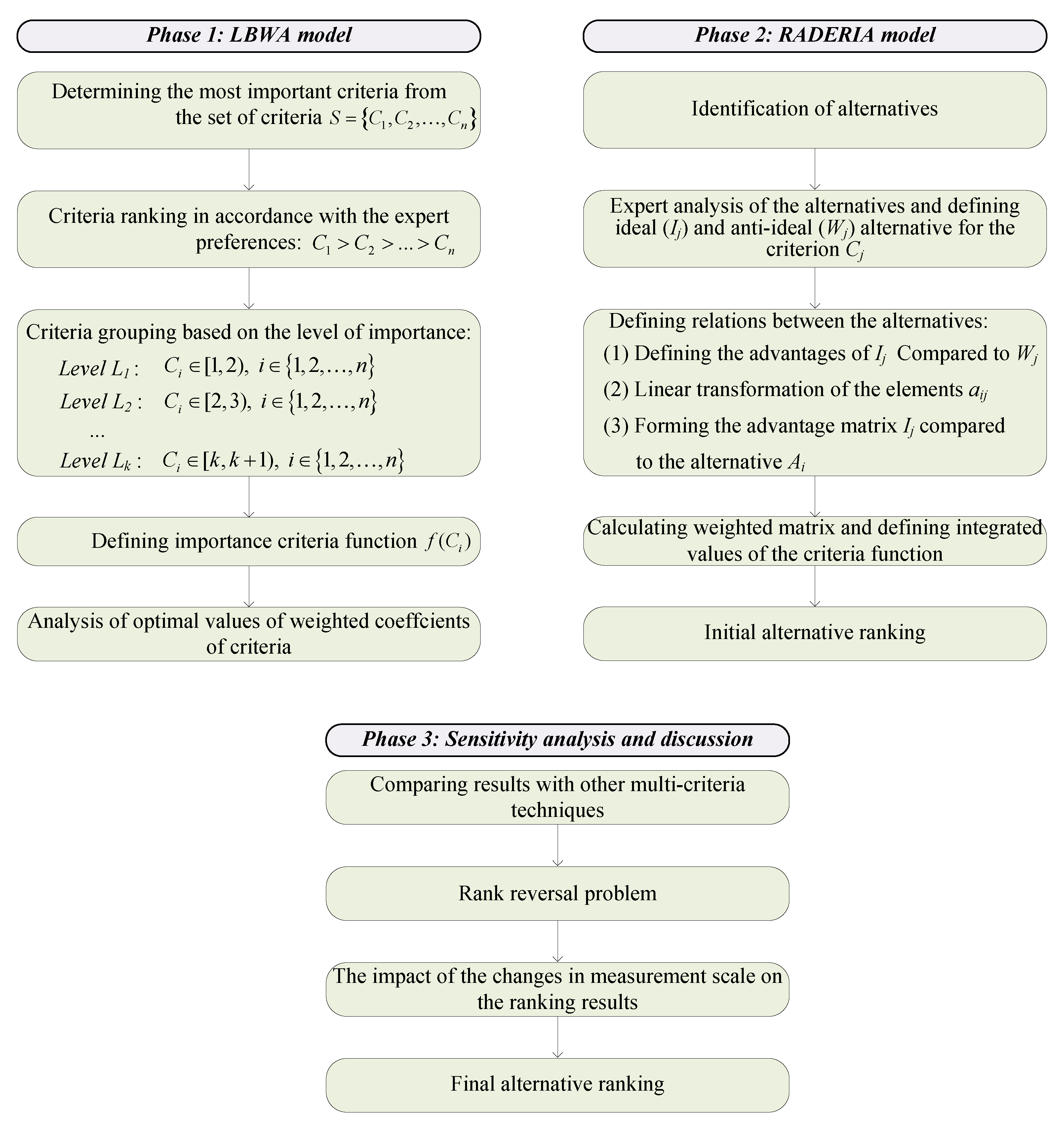
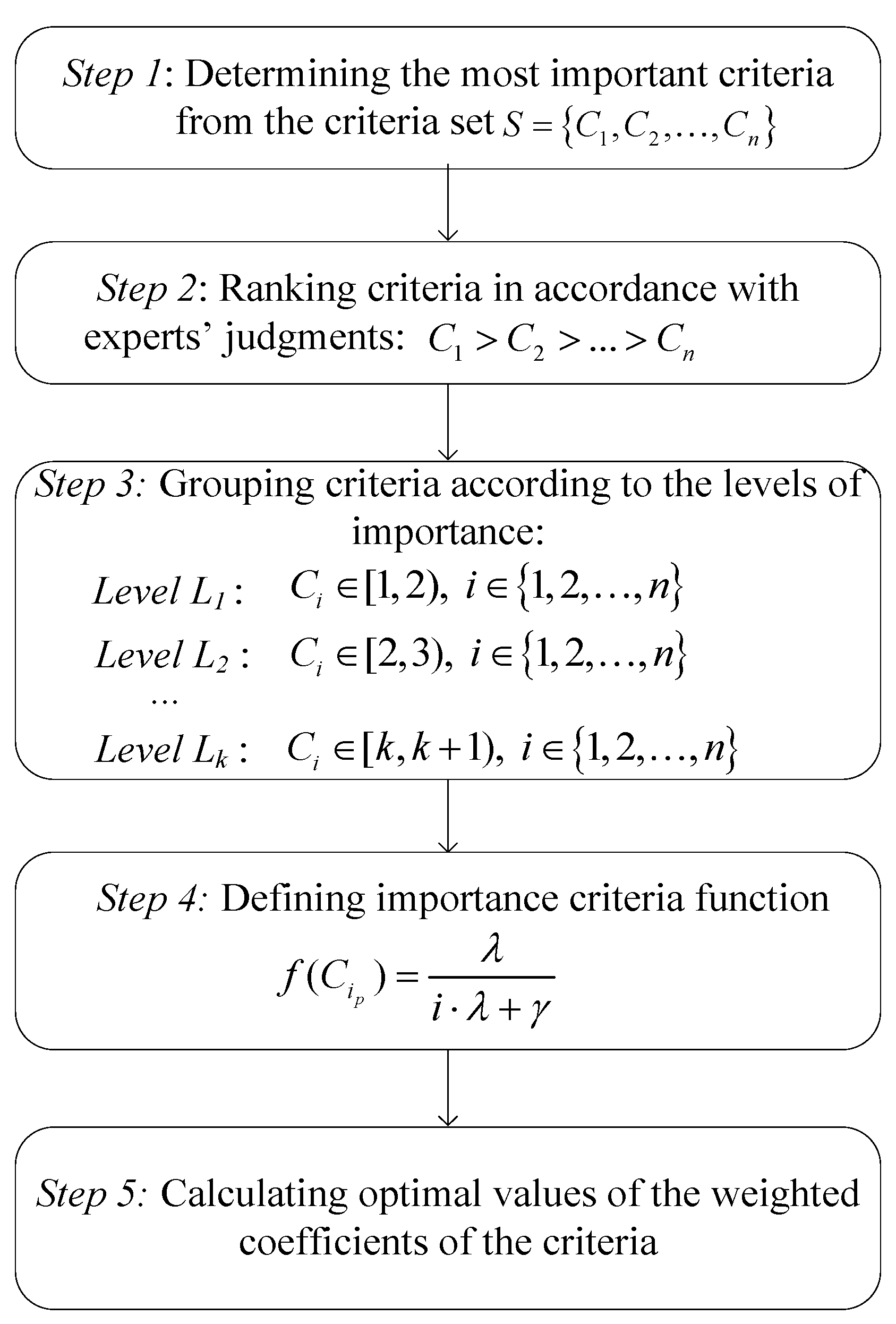


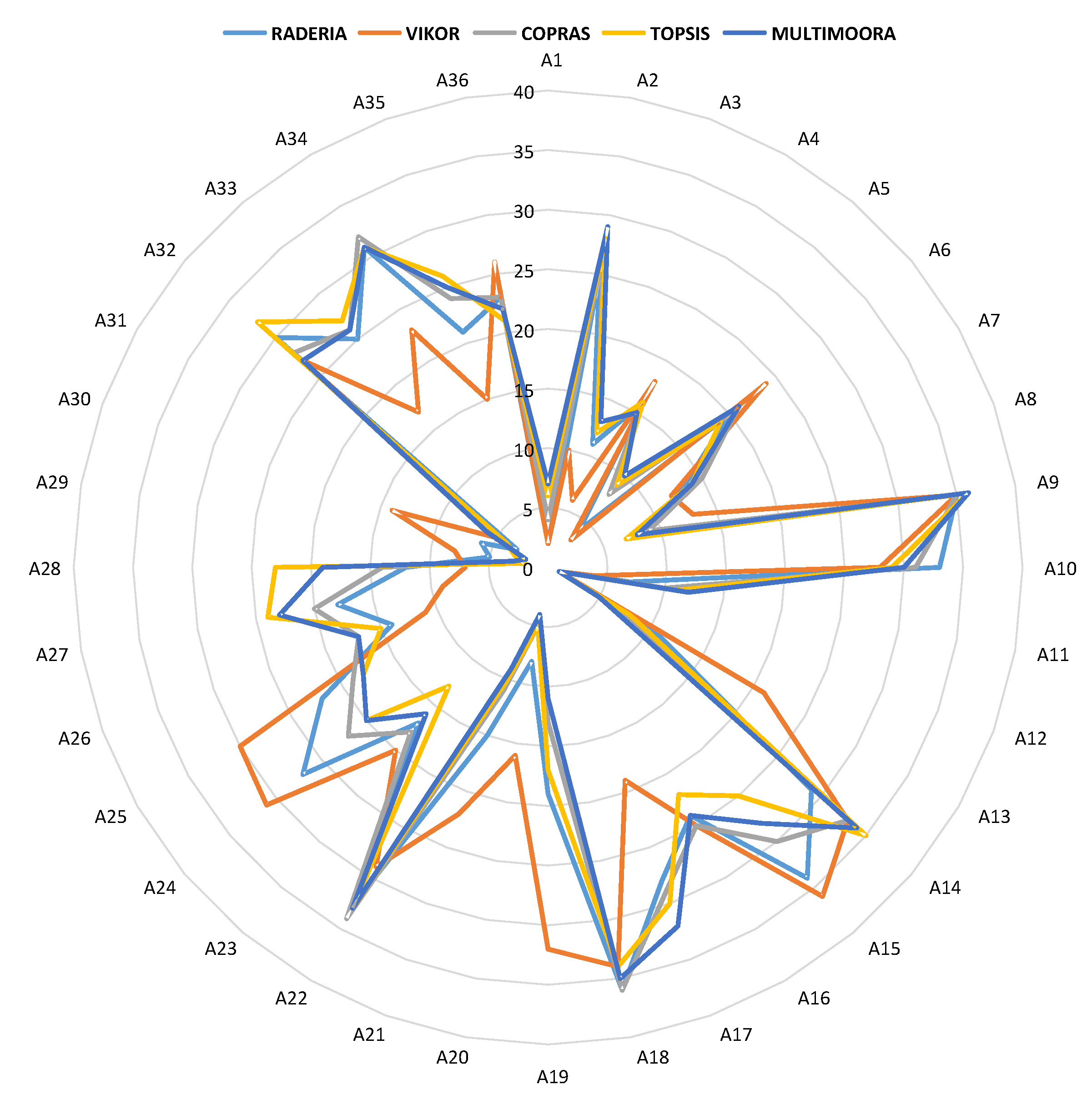
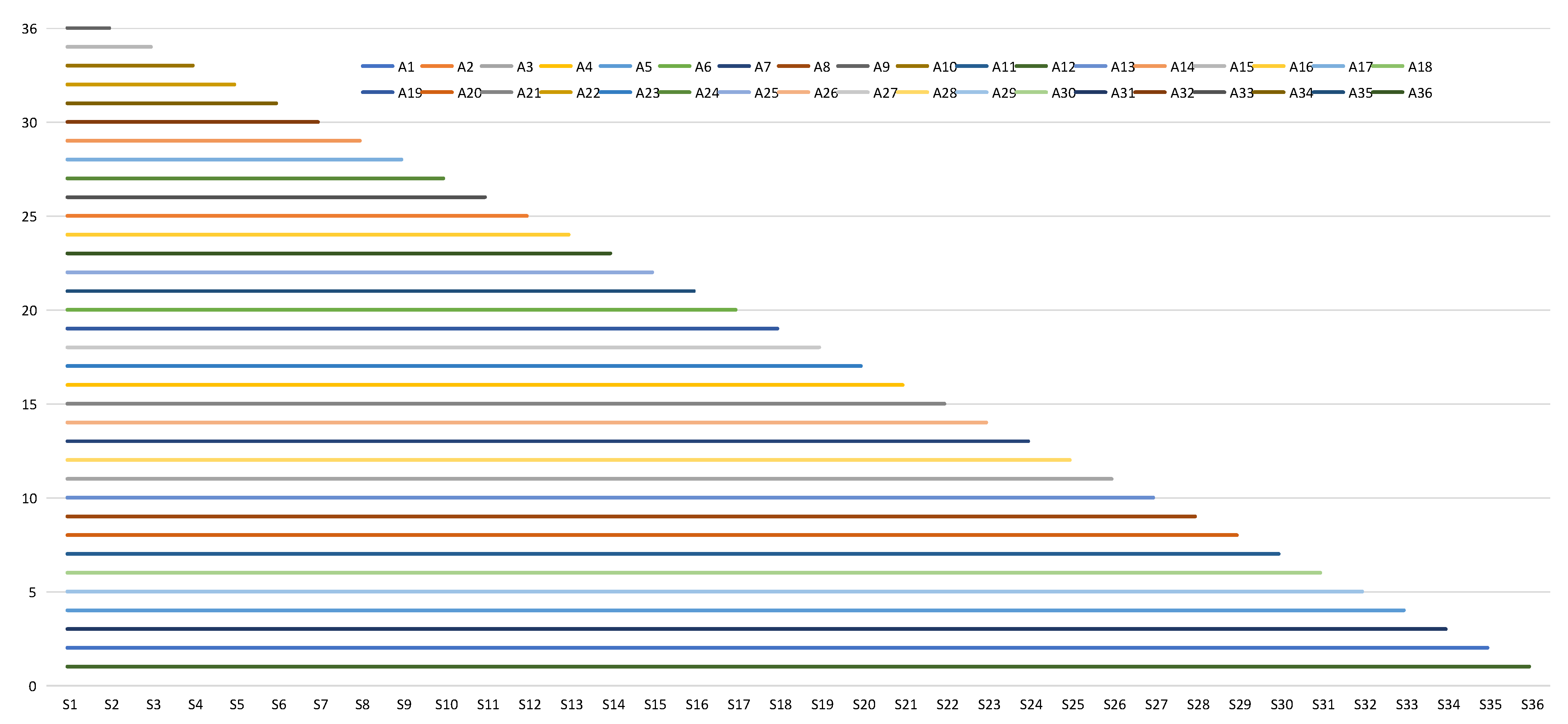
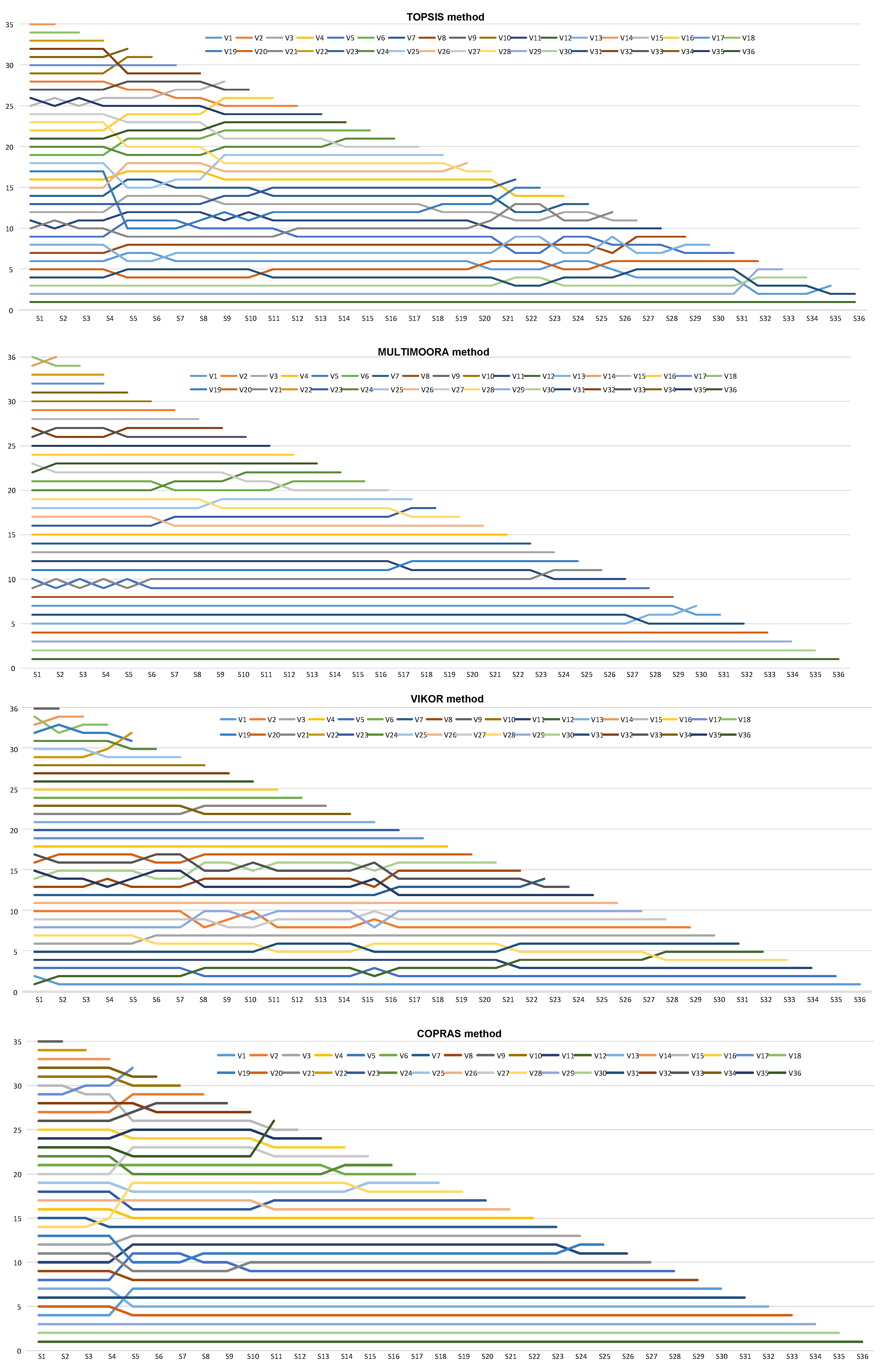
| Criteria | E1 | E2 | E3 | E4 |
|---|---|---|---|---|
| C1 | Level 1 | Level 1 | Level 1 | Level 1 |
| C2 | Level 2 | Level 1 | Level 2 | Level 1 |
| C3 | Level 3 | Level 3 | Level 3 | Level 3 |
| C4 | Level 4 | Level 4 | Level 4 | Level 4 |
| C5 | Level 5 | Level 5 | Level 5 | Level 5 |
| Experts | C1 | C2 | C3 | C4 | C5 | λ | |||||
|---|---|---|---|---|---|---|---|---|---|---|---|
| I1 | Level | I2 | Level | I3 | Level | I4 | Level | I5 | Level | ||
| E1 | 0 | S1 | 0.1 | S2 | 1 | S3 | 1 | S4 | 0.35 | S5 | 1 |
| E2 | 0 | S1 | 1.5 | S1 | 0.8 | S3 | 1 | S4 | 0.35 | S5 | 2 |
| E3 | 0 | S1 | 0.25 | S2 | 1 | S3 | 1 | S4 | 0.5 | S5 | 1 |
| E4 | 0 | S1 | 2 | S1 | 1.2 | S3 | 1 | S4 | 0.8 | S5 | 2 |
| Criteria | E1 | E2 | E3 | E4 |
|---|---|---|---|---|
| C1 | ||||
| C2 | ||||
| C3 | ||||
| C4 | ||||
| C5 |
| Criteria Weights | E1 | E2 | E3 | E4 | Average |
|---|---|---|---|---|---|
| w1 | 0.457 | 0.417 | 0.461 | 0.432 | 0.442 |
| w2 | 0.223 | 0.278 | 0.217 | 0.259 | 0.244 |
| w3 | 0.131 | 0.128 | 0.132 | 0.127 | 0.129 |
| w4 | 0.102 | 0.096 | 0.102 | 0.100 | 0.100 |
| w5 | 0.088 | 0.081 | 0.088 | 0.082 | 0.085 |
| Alternative | C1 (Min) | C2 (Min) | C3 (Max) | C4 (Max) | C5 (Max) |
|---|---|---|---|---|---|
| A1 | 28.0 | 0.000 | 7 | 7 | 5 |
| A2 | 30.0 | 0.000 | 3 | 3 | 3 |
| A3 | 29.5 | 0.000 | 5 | 5 | 7 |
| A4 | 32.0 | 0.000 | 5 | 5 | 9 |
| A5 | 28.5 | 0.000 | 5 | 5 | 9 |
| A6 | 33.5 | 0.000 | 5 | 5 | 7 |
| A7 | 31.5 | 0.000 | 5 | 5 | 9 |
| A8 | 32.0 | 0.000 | 7 | 7 | 9 |
| A9 | 33.5 | 0.030 | 3 | 3 | 9 |
| A10 | 34.0 | 0.000 | 3 | 3 | 7 |
| A11 | 28.5 | 0.000 | 5 | 5 | 7 |
| A12 | 29.5 | 0.000 | 9 | 9 | 9 |
| A13 | 33.5 | 0.000 | 9 | 9 | 7 |
| A14 | 35.0 | 0.025 | 9 | 9 | 9 |
| A15 | 36.5 | 0.000 | 5 | 5 | 5 |
| A16 | 33.5 | 0.000 | 5 | 5 | 5 |
| A17 | 31.5 | 0.000 | 3 | 3 | 3 |
| A18 | 33.5 | 0.017 | 1 | 5 | 3 |
| A19 | 36.0 | 0.000 | 9 | 9 | 5 |
| A20 | 32.5 | 0.000 | 9 | 9 | 7 |
| A21 | 33.5 | 0.000 | 9 | 9 | 3 |
| A22 | 34.0 | 0.009 | 7 | 7 | 3 |
| A23 | 32.5 | 0.000 | 7 | 7 | 3 |
| A24 | 35.0 | 0.000 | 7 | 7 | 3 |
| A25 | 35.0 | 0.000 | 7 | 7 | 5 |
| A26 | 31.0 | 0.000 | 5 | 5 | 7 |
| A27 | 30.5 | 0.000 | 3 | 3 | 9 |
| A28 | 28.5 | 0.000 | 3 | 3 | 9 |
| A29 | 31.5 | 0.000 | 9 | 9 | 7 |
| A30 | 32.5 | 0.000 | 9 | 9 | 9 |
| A31 | 29.5 | 0.000 | 7 | 7 | 7 |
| A32 | 34.0 | 0.000 | 1 | 5 | 9 |
| A33 | 31.0 | 0.000 | 3 | 3 | 5 |
| A34 | 32.5 | 0.000 | 1 | 5 | 5 |
| A35 | 31.0 | 0.000 | 3 | 3 | 7 |
| A36 | 34.0 | 0.000 | 5 | 5 | 7 |
| Ideal/Anti-Ideal Alt. | C1 | C2 | C3 | C4 | C5 |
|---|---|---|---|---|---|
| Ij | 22 | 0 | 10 | 10 | 10 |
| Wj | 40 | 2 | 1 | 1 | 1 |
| Criteria | Ij | Wj | ||||
|---|---|---|---|---|---|---|
| C1 | 22 | 0 | 40 | 2 | 30 | 1 |
| C2 | 0 | 0 | 2 | 2 | 0.02 | 1 |
| C3 | 1 | 2 | 10 | 0 | 5 | 1 |
| C4 | 1 | 2 | 10 | 0 | 5 | 1 |
| C5 | 1 | 2 | 10 | 0 | 5 | 1 |
| Alternative | C1 | C2 | C3 | C4 | C5 |
|---|---|---|---|---|---|
| A1 | 0.75 | 0.00 | 0.60 | 0.60 | 1.00 |
| A2 | 1.00 | 0.00 | 1.50 | 1.50 | 1.50 |
| A3 | 0.94 | 0.00 | 1.00 | 1.00 | 0.60 |
| A4 | 1.20 | 0.00 | 1.00 | 1.00 | 0.20 |
| A5 | 0.81 | 0.00 | 1.00 | 1.00 | 0.20 |
| A6 | 1.35 | 0.00 | 1.00 | 1.00 | 0.60 |
| A7 | 1.15 | 0.00 | 1.00 | 1.00 | 0.20 |
| A8 | 1.20 | 0.00 | 0.60 | 0.60 | 0.20 |
| A9 | 1.35 | 1.01 | 1.50 | 1.50 | 0.20 |
| A10 | 1.40 | 0.00 | 1.50 | 1.50 | 0.60 |
| A11 | 0.81 | 0.00 | 1.00 | 1.00 | 0.60 |
| A12 | 0.94 | 0.00 | 0.20 | 0.20 | 0.20 |
| A13 | 1.35 | 0.00 | 0.20 | 0.20 | 0.60 |
| A14 | 1.50 | 1.00 | 0.20 | 0.20 | 0.20 |
| A15 | 1.65 | 0.00 | 1.00 | 1.00 | 1.00 |
| A16 | 1.35 | 0.00 | 1.00 | 1.00 | 1.00 |
| A17 | 1.15 | 0.00 | 1.50 | 1.50 | 1.50 |
| A18 | 1.35 | 0.85 | 2.00 | 1.00 | 1.50 |
| A19 | 1.60 | 0.00 | 0.20 | 0.20 | 1.00 |
| A20 | 1.25 | 0.00 | 0.20 | 0.20 | 0.60 |
| A21 | 1.35 | 0.00 | 0.20 | 0.20 | 1.50 |
| A22 | 1.40 | 0.45 | 0.60 | 0.60 | 1.50 |
| A23 | 1.25 | 0.00 | 0.60 | 0.60 | 1.50 |
| A24 | 1.50 | 0.00 | 0.60 | 0.60 | 1.50 |
| A25 | 1.50 | 0.00 | 0.60 | 0.60 | 1.00 |
| A26 | 1.10 | 0.00 | 1.00 | 1.00 | 0.60 |
| A27 | 1.05 | 0.00 | 1.50 | 1.50 | 0.20 |
| A28 | 0.81 | 0.00 | 1.50 | 1.50 | 0.20 |
| A29 | 1.15 | 0.00 | 0.20 | 0.20 | 0.60 |
| A30 | 1.25 | 0.00 | 0.20 | 0.20 | 0.20 |
| A31 | 0.94 | 0.00 | 0.60 | 0.60 | 0.60 |
| A32 | 1.40 | 0.00 | 2.00 | 1.00 | 0.20 |
| A33 | 1.10 | 0.00 | 1.50 | 1.50 | 1.00 |
| A34 | 1.25 | 0.00 | 2.00 | 1.00 | 1.00 |
| A35 | 1.10 | 0.00 | 1.50 | 1.50 | 0.60 |
| A36 | 1.40 | 0.00 | 1.00 | 1.00 | 0.60 |
| Alternative | C1 | C2 | C3 | C4 | C5 | Rank | |
|---|---|---|---|---|---|---|---|
| A1 | 0.325 | 0.000 | 0.077 | 0.058 | 0.087 | 0.547 | 2 |
| A2 | 0.434 | 0.000 | 0.191 | 0.145 | 0.130 | 0.900 | 25 |
| A3 | 0.407 | 0.000 | 0.128 | 0.096 | 0.052 | 0.683 | 11 |
| A4 | 0.521 | 0.000 | 0.128 | 0.096 | 0.017 | 0.762 | 16 |
| A5 | 0.353 | 0.000 | 0.128 | 0.096 | 0.017 | 0.594 | 4 |
| A6 | 0.586 | 0.000 | 0.128 | 0.096 | 0.052 | 0.862 | 20 |
| A7 | 0.499 | 0.000 | 0.128 | 0.096 | 0.017 | 0.740 | 13 |
| A8 | 0.521 | 0.000 | 0.077 | 0.058 | 0.017 | 0.672 | 9 |
| A9 | 0.586 | 0.257 | 0.191 | 0.145 | 0.017 | 1.196 | 35 |
| A10 | 0.607 | 0.000 | 0.191 | 0.145 | 0.052 | 0.996 | 33 |
| A11 | 0.353 | 0.000 | 0.128 | 0.096 | 0.052 | 0.629 | 7 |
| A12 | 0.407 | 0.000 | 0.026 | 0.019 | 0.017 | 0.469 | 1 |
| A13 | 0.586 | 0.000 | 0.026 | 0.019 | 0.052 | 0.683 | 10 |
| A14 | 0.651 | 0.256 | 0.026 | 0.019 | 0.017 | 0.969 | 29 |
| A15 | 0.716 | 0.000 | 0.128 | 0.096 | 0.087 | 1.027 | 34 |
| A16 | 0.586 | 0.000 | 0.128 | 0.096 | 0.087 | 0.897 | 24 |
| A17 | 0.499 | 0.000 | 0.191 | 0.145 | 0.130 | 0.965 | 28 |
| A18 | 0.586 | 0.217 | 0.255 | 0.096 | 0.130 | 1.285 | 36 |
| A19 | 0.694 | 0.000 | 0.026 | 0.019 | 0.087 | 0.826 | 19 |
| A20 | 0.542 | 0.000 | 0.026 | 0.019 | 0.052 | 0.639 | 8 |
| A21 | 0.586 | 0.000 | 0.026 | 0.019 | 0.130 | 0.761 | 15 |
| A22 | 0.607 | 0.115 | 0.077 | 0.058 | 0.130 | 0.987 | 32 |
| A23 | 0.542 | 0.000 | 0.077 | 0.058 | 0.130 | 0.807 | 17 |
| A24 | 0.651 | 0.000 | 0.077 | 0.058 | 0.130 | 0.915 | 27 |
| A25 | 0.651 | 0.000 | 0.077 | 0.058 | 0.087 | 0.872 | 22 |
| A26 | 0.477 | 0.000 | 0.128 | 0.096 | 0.052 | 0.753 | 14 |
| A27 | 0.456 | 0.000 | 0.191 | 0.145 | 0.017 | 0.809 | 18 |
| A28 | 0.353 | 0.000 | 0.191 | 0.145 | 0.017 | 0.706 | 12 |
| A29 | 0.499 | 0.000 | 0.026 | 0.019 | 0.052 | 0.596 | 5 |
| A30 | 0.542 | 0.000 | 0.026 | 0.019 | 0.017 | 0.605 | 6 |
| A31 | 0.407 | 0.000 | 0.077 | 0.058 | 0.052 | 0.593 | 3 |
| A32 | 0.607 | 0.000 | 0.255 | 0.096 | 0.017 | 0.977 | 30 |
| A33 | 0.477 | 0.000 | 0.191 | 0.145 | 0.087 | 0.900 | 25 |
| A34 | 0.542 | 0.000 | 0.255 | 0.096 | 0.087 | 0.981 | 31 |
| A35 | 0.477 | 0.000 | 0.191 | 0.145 | 0.052 | 0.865 | 21 |
| A36 | 0.607 | 0.000 | 0.128 | 0.096 | 0.052 | 0.884 | 23 |
| MCDM Model | RADERIA | VIKOR | COPRAS | TOPSIS | MULTIMOORA |
|---|---|---|---|---|---|
| RADERIA | 1.000 | 0.832 | 0.968 | 0.938 | 0.930 |
| VIKOR | - | 1.000 | 0.712 | 0.644 | 0.620 |
| COPRAS | - | - | 1.000 | 0.968 | 0.987 |
| TOPSIS | - | - | - | 1.000 | 0.982 |
| MULTIMOORA | - | - | - | - | 1.000 |
Publisher’s Note: MDPI stays neutral with regard to jurisdictional claims in published maps and institutional affiliations. |
© 2021 by the authors. Licensee MDPI, Basel, Switzerland. This article is an open access article distributed under the terms and conditions of the Creative Commons Attribution (CC BY) license (https://creativecommons.org/licenses/by/4.0/).
Share and Cite
Jakovljevic, V.; Zizovic, M.; Pamucar, D.; Stević, Ž.; Albijanic, M. Evaluation of Human Resources in Transportation Companies Using Multi-Criteria Model for Ranking Alternatives by Defining Relations between Ideal and Anti-Ideal Alternative (RADERIA). Mathematics 2021, 9, 976. https://doi.org/10.3390/math9090976
Jakovljevic V, Zizovic M, Pamucar D, Stević Ž, Albijanic M. Evaluation of Human Resources in Transportation Companies Using Multi-Criteria Model for Ranking Alternatives by Defining Relations between Ideal and Anti-Ideal Alternative (RADERIA). Mathematics. 2021; 9(9):976. https://doi.org/10.3390/math9090976
Chicago/Turabian StyleJakovljevic, Vladimir, Mališa Zizovic, Dragan Pamucar, Željko Stević, and Miloljub Albijanic. 2021. "Evaluation of Human Resources in Transportation Companies Using Multi-Criteria Model for Ranking Alternatives by Defining Relations between Ideal and Anti-Ideal Alternative (RADERIA)" Mathematics 9, no. 9: 976. https://doi.org/10.3390/math9090976
APA StyleJakovljevic, V., Zizovic, M., Pamucar, D., Stević, Ž., & Albijanic, M. (2021). Evaluation of Human Resources in Transportation Companies Using Multi-Criteria Model for Ranking Alternatives by Defining Relations between Ideal and Anti-Ideal Alternative (RADERIA). Mathematics, 9(9), 976. https://doi.org/10.3390/math9090976








